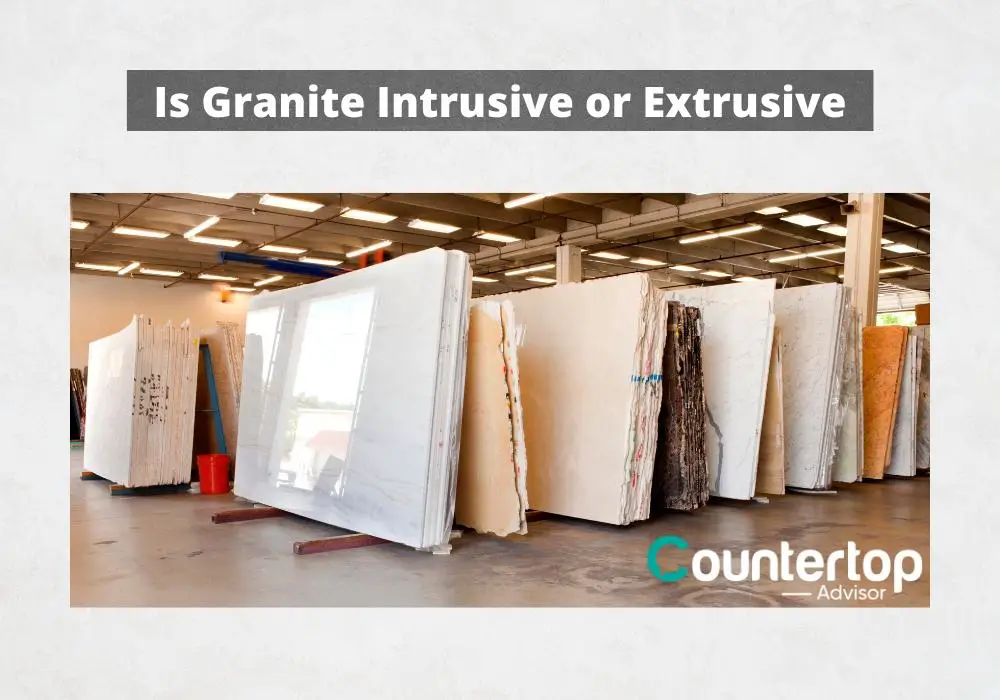Granite is one of the most widely used and admired natural stones in construction, home design, and geology. Its durability, aesthetic appeal, and resistance to wear make it ideal for countertops, flooring, and building facades. But one fundamental question often arises in both scientific and design communities: Is granite extrusive or intrusive?
In this article, we’ll explore the geological classification of granite, its formation process, and how this knowledge can help homeowners and professionals make better-informed decisions when selecting and maintaining granite countertops and surfaces.

What Is Granite?
Granite is a coarse-grained igneous rock composed mainly of quartz, feldspar, and mica. Its characteristic appearance includes interlocking mineral crystals that give it strength and visual appeal.
Explore more: Is Granite Igneous?
It’s this composition that makes granite stone an ideal candidate for use in:
- White granite countertops
- Black granite countertops
- Granite backsplash designs
- High-end kitchen and bathroom vanities

Igneous Rocks: Intrusive vs. Extrusive
Before diving into granite specifically, it’s essential to understand the two main categories of igneous rocks:
What Are Igneous Rocks?
Igneous rocks are formed from the cooling and solidification of molten rock (magma or lava). They are classified into two primary types:
- Extrusive Igneous Rocks: Form on the Earth’s surface when lava cools rapidly (e.g., basalt, pumice)
- Intrusive Igneous Rocks: Form beneath the surface when magma cools slowly (e.g., granite, diorite)
Is Granite Extrusive or Intrusive?
Granite’s Geological Classification
Granite is an intrusive igneous rock. It forms deep within the Earth’s crust, where magma cools gradually over millions of years. This slow cooling allows large, visible crystals to develop—one of granite’s defining characteristics.
Related read: Is Granite an Igneous Rock?
This classification matters not only to geologists but also to builders and homeowners because it directly relates to the strength, appearance, and durability of the stone.
Characteristics of Intrusive Granite
Texture and Grain
Because granite forms underground, it exhibits a coarse-grained texture with clearly visible crystals of quartz, feldspar, and mica.
Durability and Hardness
Its slow crystallization process results in a dense and hard surface, making granite one of the most durable natural stones. It’s ideal for high-traffic areas and heavy-use kitchen countertops.
Natural vs. Engineered Granite
Natural Granite
Quarried from the Earth, natural granite retains the unique geological traits of its origin. Each slab varies in pattern and color, offering truly one-of-a-kind aesthetics.
Engineered Granite
Sometimes referred to as composite or hybrid granite, engineered granite combines natural granite stone particles with resins and pigments for uniformity and reduced porosity. This option is popular in modern kitchens that prioritize low maintenance and visual consistency.
Common Uses of Granite
Because of its appealing characteristics, granite is used in:
- Granite kitchen countertops
- Bathroom vanities
- Outdoor kitchens
- Granite fireplace surrounds
- Flooring and wall cladding
Its strength and resistance to heat, moisture, and scratching make it a top choice for surfaces in both residential and commercial settings.
Granite Maintenance and Surface Care
Cleaning and Polishing
Clean granite countertops regularly with a pH-neutral stone cleaner. Avoid harsh chemicals that could damage the sealant.
For restoration:
Sealing Granite
Granite surfaces must be sealed to protect against stains and moisture intrusion. Depending on the usage level and granite porosity, sealing should be done every 1–3 years.
Comparing Granite with Other Stones
| Feature | Granite | Marble | Quartz | Soapstone |
|---|---|---|---|---|
| Rock Type | Igneous | Metamorphic | Engineered | Metamorphic |
| Durability | High | Medium | High | Medium |
| Maintenance | Moderate | High | Low | Moderate |
| Heat Resistance | Excellent | Good | Good | Good |
| Cost | Moderate–High | High | Moderate | Moderate |
Granite outperforms many alternatives when it comes to cost-effectiveness and durability, making it one of the best natural stone countertop options on the market.
Sourcing and Pricing
Granite Countertop Cost
Granite pricing varies by type, color, thickness, and origin. You can find:
- Affordable granite countertop options
- Wholesale granite suppliers
- Aardwolf premium granite slabs for custom installation
Use the right gear when transporting granite: Suction Cup for Material Handling
Where to Buy Granite
Local showrooms and suppliers often provide a wide selection of granite colors and finishes, including:
- White granite countertops
- Black granite countertops
- Exotic patterns and veining
Look for reputable vendors like the Aardwolf granite countertop collection for quality assurance and installation services.
Final Thoughts: Why Granite’s Formation Matters
Understanding that granite is intrusive—not extrusive— helps explain why it’s so durable, reliable, and visually stunning. Its underground formation process allows for a dense, crystal-rich structure perfect for countertops, floors, and decorative features.
Whether you’re designing a luxury kitchen or exploring natural stone for your home, granite offers a winning combination of geological strength and timeless appeal.
Related reading:

